
- Usage in publication:
-
- Mojado Formation
- Modifications:
-
- Areal extent
- AAPG geologic province:
-
- Pedregosa basin
Summary:
Extended to southern Animas Mountains, Hidalgo Co, NM, in Pedregosa basin. Is of Early Cretaceous age.
Source: GNU records (USGS DDS-6; Denver GNULEX).
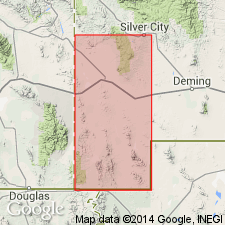
- Usage in publication:
-
- Mojado Formation
- Modifications:
-
- Named
- Dominant lithology:
-
- Sandstone
- Shale
- AAPG geologic province:
-
- Pedregosa basin
Summary:
Named for Mojado Pass. Type section measured in S1/2 sec 20, T32S, R15W, Hidalgo Co., NM, Pedregosa basin. Divided into lower and upper members. Lower member, about 4,100 ft-thick, is interbedded gray sandstone composed of angular to subangular, medium and fine sand and some beds with feldspar and biotite, mostly weakly cemented and gray shale 4,109 ft-thick at type. Upper member composed of gray quartz sandstone that may be fine to medium grained thin-bedded, cross-laminated, and a few beds of medium brown, silty limestone and calcareous siltstone, 1,086 ft-thick at type. Conformably overlies U-Bar Formation (new) and unconformably overlain by Tertiary deposits. Lower member contains equivalents of some of the Fredericksburg and the lower and possibly the middle Washita. The upper member is of middle or late Washita age. Is of Early Cretaceous age. Fossil gastropods, ammonites, mollusks, pelecypods, etc. identified. Correlation with parts of Bisbee Group suggested.
Source: GNU records (USGS DDS-6; Denver GNULEX).
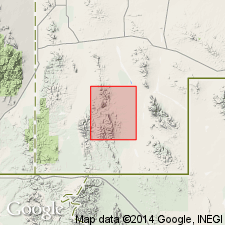
- Usage in publication:
-
- Mojado Formation
- Modifications:
-
- Revised
- Overview
- AAPG geologic province:
-
- Pedregosa basin
Summary:
Underlies newly named Cowboy Spring Formation transitionally. Overlies U-Bar Formation conformably. Not well exposed in quad. Thickness estimated to be between 5,150 ft and 7,800 ft. A zone of marine limestone contains forams, pelecypods, scaphopods, gastropods, and cephalopods. These fossils suggest a late Comanche, late Albian, Early Cretaceous age. TEMPSKYA also found. Geologic map. Section 1,688.5 ft thick measured in sec 2, T31S, R18W. Report area is within Pedregosa basin.
Source: GNU records (USGS DDS-6; Denver GNULEX).
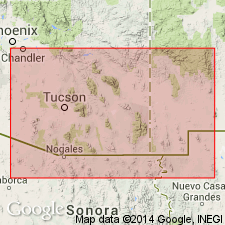
- Usage in publication:
-
- Mojado Formation*
- Modifications:
-
- Age modified
- Overview
- AAPG geologic province:
-
- Pedregosa basin
Summary:
Is formation in Big Hatchet and Animas Mountains, Hidalgo Co, NM in Pedregosa basin. Overlies U-Bar Formation (Aptian and Albian) of Zeller, Jr. (1965). Underlies Cowboy Spring Formation (Upper Cretaceous) of Zeller, Jr., and Alper (1965) with parallel but disconformable contact. Is 5,195 ft thick in Big Hatchet Mountains. Lower 4,109 ft may be equivalent to Cintura Formation in Mule Mountains. Upper 1,086 ft may be related to strata of very early Late Cretaceous age to north in Silver City-Santa Rita area, NM. [See fig. 5 for regional correlations.] Lower part represents continental deltaic sedimentation. Age changed from Albian to Albian and early Cenomanian (late Early and early Late Cretaceous) on basis of correlation.
Source: GNU records (USGS DDS-6; Denver GNULEX).

- Usage in publication:
-
- Mojado Formation
- Modifications:
-
- Areal extent
- AAPG geologic province:
-
- Pedregosa basin
- Basin-and-Range province
Summary:
Extended to Little Hatchet Mountains in the Pedregosa basin and Basin-and-Range province of Grant and Hidalgo Cos, NM, to replace Corbett Sandstone and, locally, part of Broken Jug Limestone [an excellent thing to do]. Is conformable on U-Bar Formation and unconformable beneath Ringbone Formation. Has same lithology as in Big Hatchet and Animas Mountains (gray and tan quartzite, shale interbeds, few thin limestones near top). Is 5,000 ft thick. Is of Early Cretaceous age. Mollusks of late Washita age in calcareous beds. Geologic map. Cross sections.
Source: GNU records (USGS DDS-6; Denver GNULEX).
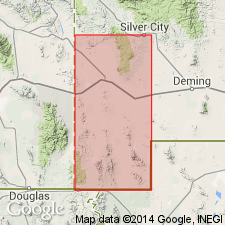
- Usage in publication:
-
- Mojado Formation
- Modifications:
-
- Areal extent
- AAPG geologic province:
-
- Pedregosa basin
Summary:
Extended within Pedregosa basin to northern Animas Mountains. Is of Early Cretaceous age.
Source: GNU records (USGS DDS-6; Denver GNULEX).
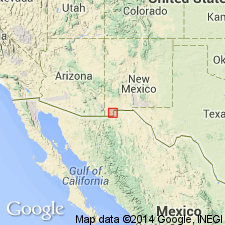
- Usage in publication:
-
- Mojado Formation*
- Modifications:
-
- Areal extent
- Overview
- AAPG geologic province:
-
- Pedregosa basin
Summary:
As defined by Zeller (1965), used in Big Hatchet Mountains area, Animas Mountains, and Sierra Rica of Pedregosa basin. Marine fauna (forams, mollusks, pelecypods, gastropods, cephalopods, etc) 4,000-5,000 ft above base. Of Albian, Early Cretaceous age.
Source: GNU records (USGS DDS-6; Denver GNULEX).
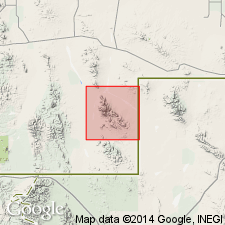
- Usage in publication:
-
- Mojado Formation
- Modifications:
-
- Revised
- AAPG geologic province:
-
- Pedregosa basin
Summary:
Shown on map explanation as top formation of Bisbee Group. Is of Early Cretaceous age.
Source: GNU records (USGS DDS-6; Denver GNULEX).
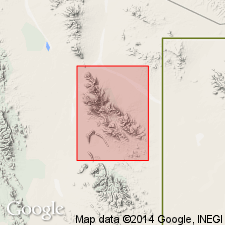
- Usage in publication:
-
- Mojado Formation*
- Modifications:
-
- Mapped 1:24k
- Dominant lithology:
-
- Siltstone
- Shale
- Sandstone
- AAPG geologic province:
-
- Pedregosa basin
Summary:
Mojado Formation, uppermost formation of Bisbee Group. Mapped in Big Hatchet Mountains, Hidalgo County, southwestern New Mexico. Siltstone, shale, and sandstone; some marine limestone near top, just south of map area. Typically pale yellowish brown to light brownish gray, thin-bedded, weakly indurated. Thickness 5,195 feet (1,590 m) (Zeller, 1965). Above U-Bar Formation of Bisbee Group. Age is Early Cretaceous.
Source: Publication.
For more information, please contact Nancy Stamm, Geologic Names Committee Secretary.
Asterisk (*) indicates published by U.S. Geological Survey authors.
"No current usage" (†) implies that a name has been abandoned or has fallen into disuse. Former usage and, if known, replacement name given in parentheses ( ).
Slash (/) indicates name conflicts with nomenclatural guidelines (CSN, 1933; ACSN, 1961, 1970; NACSN, 1983, 2005, 2021). May be explained within brackets ([ ]).

